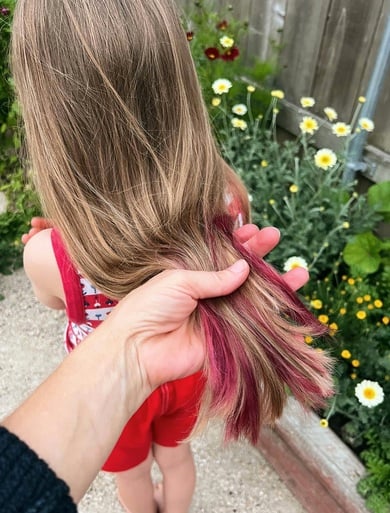
We get mordant questions all the time at Botanical Colors so why not create Mordant Monday??? Got mordanting questions? Email [email protected]
(Image: The Dogwood Dyer)
YOU ASKED: Hi there! I’m interested in your products, particularly the cochineal, and I’m wondering if I can use it for dyeing my hair. If so, do the same instructions work that are listed here? I’ve seen The Dogwood Dyer’s instructions here and it sounds like she’s putting the alum directly in the dye. I’d like to achieve a pink color like what she did. I’d so appreciate if you could help me understand exactly how best to use your cochineal to dye my hair. Thank you so much in advance!
KATHY ANSWERED: We don’t use cochineal on hair but the IG link from the Dogwood Dyer is super clear and simple and has step by step instructions. If you want to purchase the ingredients, you would need whole cochineal insects and aluminum sulfate. She also used guar gum to thicken the mixture a little and we have a food grade printing paste in powder form that will also serve as a thickener. I think if you start with 2 tablespoons of cochineal insects (you can use whole or crush with a mortar and pestle) that would be enough to make about 1-2 cups of color.
I do not have any information on how long this would last as we don’t use cochineal this way but I hope that helps clarify the ingredients that she’s talking about.
YOU ASKED: I have some white 70% angora/30% merino I want to naturally dye. My go-to recipe for mordanting is aluminum potassium sulfate at 14% WOF. I have heard angora can be tricky to dye because it’s water resistant and delicate. I’m also worried about the fiber becoming “gummy” because of the mordant. Do you have any tips?
KATHY ANSWERED: If you are concerned about alum causing stickiness or gumminess, you might try reducing the percentage of alum that you use. Some dyers use 7% alum to avoid hand feel issues. Traditionally, dyers also used cream of tartar in the mordant bath, which was useful in maintaining a soft hand in wool and animal fibers. The amounts of cream of tartar vary from 3-5% wof. You might also experiment with aluminum triformate, which avoids heating the mordant bath, and could help keep the fibers softer. I love to play around with modifying Ph and using iron post baths.
Raising the pH and heating the dye bath for animal fibers can cause fibers to feel harsh, so be aware when modifying pH. Iron is also known to harshen animal fibers, so for softest results, avoid it or use small amounts (0.25-1.0%) in a cold post-bath.
YOU ASKED: I make dog toys from felted wool and cotton and am interested in adding color to my product via your natural dyes. Is it safe to use mordant (alum or tannin?) and natural dyes on the fibers for this purpose?
KATHY ANSWERED: Thank you for your question. We get this type of inquiry frequently and although our ingredients are generally considered non-toxic, they aren’t edible, and there isn’t a lot of research into natural dyes and pet toys. The amount of chemicals (mordants and dyes) is a very small amount per toy so it is possible there would be no ill effects but it is not something that we have experience with.

Something else that can be very helpful for wetting angora is soaking it in room temperature water with a few drops of surfactant like synthropol or Dawn to remove the static charge that the wool has.
This will also take care of any dander and oils and make dyeing much easier.
Thank you, Angela. This is a great idea to condition the water slightly to help unruly fibers. Thank you for the suggestion! Kathy